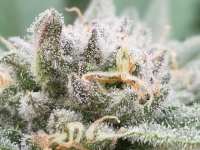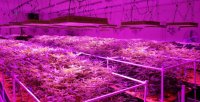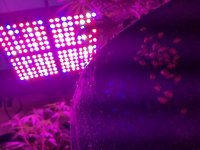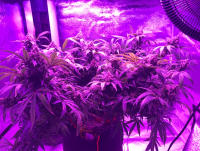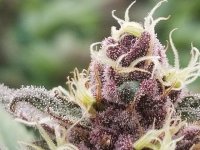what about "Galaxyhydro 300" ? cheap LED but gives great yieldsthose cfls wont be doung much at all from that height.
A piece of advice for anyone thinking of low budget... Go with HPS!!!!! You cant do low budget LED, not with anything worth growing. I know people will jump on me and disagree, however ive grown probably 30000 plants or so and theres not much i havent saeen when it comes to growing. If you want anything worthwhile then 400w per m2 s minimum requirement. HPS does not cost more than LED to run when like for like and at budget prices HPS is far superior to LED. Quality LEDs are fantastic but you must be prepared to pay for them.
Navigation
Install the app
How to install the app on iOS
How To Use Progressive Web App aka PWA On 420 Magazine Forum
Note: This feature may not be available in some browsers.
More options
You are using an out of date browser. It may not display this or other websites correctly.
You should upgrade or use an alternative browser.
You should upgrade or use an alternative browser.
Budget LED grow lights
- Thread starter Parkintheroof
- Start date
I was contemplating buying the mars 1600w for my 4x4 tent, im kind of shying away from their brand due to so many reviews of break downs with the first year as well as they just send you the spare parts to replace yourself, again shady lol. Your opinion?
How so? Most breakdowns appear to be partial ones. As I understand it, the customer has the option of shutting down his/her grow, cleaning up the light, boxing it properly for shipment, sending it back to the manufacturer... and waiting for the repaired product to return.
Or he/she can simply continue using the light while the manufacturer ships the parts to the grower, then swaps the components - which is generally a relatively simple operation - and continues with the grow. If the repair is done during the dark period, the plants never even notice.
Now if you're running half a dozen lights, lol, I don't suppose it really matters (especially since people running larger grows with multiple light sources... ought to have a spare of some sort in the cupboard for emergency use anyway
 ). But if you are only running a single-light grow... Which option would YOU prefer?
). But if you are only running a single-light grow... Which option would YOU prefer?With the luxmeter I was getting almost same lux values at the same distance but the 600w one consumes less power.
Not exactly a helpful tool, IMHO, unless you're setting up area lighting for people to use instead of plants. A lux meter doesn't measure PAR (photosynthetically active radiation), or even gross light amounts. Lux is derived from lumen (luminous flux). A lux is simply one lumen per square meter.
Luminous flux is NOT radiant flux! It's weighted toward the frequencies that our eyeballs perceive as being brighter. And luminous flux is definitely not PAR.
At best, such a device is usable when comparing two light sources where the only difference is power (wattage). For example, a 600-watt HPS will score higher on such a meter than a 400-watt one (at least, assuming the makeup of the bulbs are similar, et cetera). If you have an LED panel running at 300 watts and you drive the same model of panel at a higher wattage, it'll score higher on the lux meter. But your electrical bill, the products specifications sheets, and common sense would tell you the same thing.
It is not helpful - and could easily be a detriment - to use a lux meter to compare different models of LED products. Why? You can take a LED panel, swap out some diodes - thereby changing the spectral output of the thing - to increase luminous flux without having to increase power... and easily end up with a product that is LESS capable of growing plants.
It's output would appear brighter to the Mark I Eyeball, Human, though. I guess if you like reading the Sunday morning newspaper in your growroom, well, this could provide some benefit - to YOU
 . Me, I'd rather help the plants and go read my paper under a desk lamp...
. Me, I'd rather help the plants and go read my paper under a desk lamp...Increase the GREEN in a LED panel's output, and lux / lumen / luminous flux goes way up. Now... it appears that plants do use *SOME* green light for *SOME* processes - but a spike in green is not going to do much in terms of increasing yield, lol. I doubt you'd even notice the difference. Err... Unless you happen to be looking at a lux meter.
I'm probably horrible at explaining this stuff. For some decent consumer-level education, there's always Wikipedia, lol. See:
Lumen (unit) - Wikipedia
Lux - Wikipedia
Photosynthetically active radiation - Wikipedia
I just did a quick search for a web page that discusses the difference between PAR and the other types of measurements discussed above, but about the only things I saw were from sellers of LED panel grow lights. I'm hesitant to post those, out of consideration to our sponsors. But in the end, I decided the positive (information) might outweigh the negative - so I'll post one such link. If anyone is familiar enough with those of our sponsors who sell LED lighting, though, and find something of this nature at one of our sponsor's websites, feel free to use the Report Post function and ask a staff member to swap links (thanks!).
Code:
https://fluence.science/science/par-ppf-ppfd-dli/Mayne
Well-Known Member
what about "Galaxyhydro 300" ? cheap LED but gives great yields
Its good for seedlings, at 18inches its 245 PAR. 6 inches from center, you get around 120par, which is horrible.
Garbage waste of money.
Decent flower needs 400PAR, but if you drop it closer, your foot print is less the size of the light itself.
Its good for seedlings, at 18inches its 245 PAR. 6 inches from center, you get around 120par, which is horrible.
Meant for growing moss, perhaps?
 .
.400PAR
You mean PPFD? "PAR" isn't a unit of measurement.
If so, I would have thought the recommended minimum to be somewhat higher. Which... is kind of reassuring, actually (I have a low-wattage LED panel about to go into service).
what about 'Lumigrow(with spectrum control) or cailfornia light works (550 solarsystem) does KInd Led rate !!!! Looking at these three - thought's ?Its good for seedlings, at 18inches its 245 PAR. 6 inches from center, you get around 120par, which is horrible.
Garbage waste of money.
Decent flower needs 400PAR, but if you drop it closer, your foot print is less the size of the light itself.
are they of amason ? (45 watt panels's)(12by12 ?) have use two off them as side lighting which really increased yields !!!!Meant for growing moss, perhaps?.
You mean PPFD? "PAR" isn't a unit of measurement.
If so, I would have thought the recommended minimum to be somewhat higher. Which... is kind of reassuring, actually (I have a low-wattage LED panel about to go into service).
Mayne
Well-Known Member
Meant for growing moss, perhaps?.
You mean PPFD? "PAR" isn't a unit of measurement.
If so, I would have thought the recommended minimum to be somewhat higher. Which... is kind of reassuring, actually (I have a low-wattage LED panel about to go into service).
PAR is a measurement, its just a direct spot measurement, but yes, 400ppfd would be good, and could be great, if your area is dialed in perfectly. ppfd is just a cumilational average of par measurments thruought the entire area, and not just spot measurement.
Purpsmagurps
Well-Known Member
just check out HLG for a quantum board kit. you wont have to worry about heat and will be BRIGHT! go 3000k. will be a better grow 

Mayne
Well-Known Member
QBs are awesome, Id like to have a set-up myself i guess, lol..
But I love my Cobs thus far.
But I love my Cobs thus far.
Gala420
Well-Known Member
Are you saying leds reds and blues are a scam... Because in nature it may best for the plant to break down the light spectrum it needs on its own... Kinda like go outside a getting some sun instead of taking a vitamin e tabletHi
After having testing different cheap led lights I would really advise you toplanet 600w white full spectrum. Have a look at random Ryan videos on YouTube. He compares blue red led lights to white full spectrum and have better results with the white as it provides a full range with uv addition. For the money you were ready to spend you could get two of it and have better coverage of you space. Honestly you won't regret it! I had different led lights before that one Mike for example bestva 2000w etc.... None of them were as good as the white full spectrum one. With the luxmeter I was getting almost same lux values at the same distance but the 600w one consumes less power. Don't know what more to tell you to convince you. I say convince as you should really get it and you won't be disappointed. In the range of the cheap led lights it the best one. I had made lots of research on the web to find the best for the money. Take a look at my grow I ve shared some interesting links about lights but also a picture showing how my plants under the white light had grown more than the parts under blue and red. I had already seen tests on the net but i could verify it in live! Also invest in a lux meter. Get the same the guy use in his videos. Thanks to it you will be able to use your lights accurately. Most of the led lights can grow. The difference is then in how much heat they spread, penetration, lux, etc... But after trying different models I ve realized the most important thing is the height you place them. That is what really will make the difference. Most of the cheap lights use the same led chips.... So be sure to take the luxmeter to make everything efficient. Another little advantage of the white leds is that you can see your plants better and without having to shut down the light. Just another +....... But again trust me you won't be disappointed with the toplanet white full spectrum 600w. And for the money of the one you were going to buy juste take two to cover more surface. Ps: I said toplanet cause it s the only brand I ve seen around my place that sells the 600w white full spectrum model but it could have been any other brand as I have no interest in neither.
I ll conclude that even if I m no expert and haven't been able to test all the models, the one I ve been talking about since the beginning of this post maybe be the best bang for the buck out of every other stuff I ve seen
vyserage
Well-Known Member
Just to update, I did end up getting the Mars 1600 and used it in 4x4 tent for the first 2 months of my grow before realising it was incredibly inefficient for everything outside directly under the light.
I ended up ordering the qb132 x12 for my 4x4 and they work amazingly.
I ended up ordering the qb132 x12 for my 4x4 and they work amazingly.
gbauto
Well-Known Member
750W of QB's in a 4x4? Hope you have some co2 plumbed or some dimming because that would give you way over 1000umole PPFD. Nice rig and the growth looks marvelous.
Mars Hydro
420 Sponsor
750W of QB's in a 4x4? Hope you have some co2 plumbed or some dimming because that would give you way over 1000umole PPFD.
So... sativa-ready, lol?
vyserage
Well-Known Member
Haha I wish I could use co2, tents in my room where I sleep. I plan to dim them to 100watts each during veg, and right now I keep them at 200watts per row to help save on energy and because I can't raise the light anymore.750W of QB's in a 4x4? Hope you have some co2 plumbed or some dimming because that would give you way over 1000umole PPFD. Nice rig and the growth looks marvelous.
I like that, regardless of whether you're under-driving your lights or running full-tilt bozo, you've still got full, even coverage and minimized shadowed areas. If you had a non-dimming setup, you'd be forced to shut part of it down if I wanted/needed to either run less lighting or use less electricity.
vyserage
Well-Known Member
Thanks! I was quite happy with how it turned out :3 So far the results are amazing, i can only imagine how it would have done if my entire grow from day 1 was with this qb.
Stunned
Well-Known Member
QB's really are taking over the industry as in revolution
High quality COB's are also a very good choice
I have nothing but respect for Cree's, Bridgelux, Luminous ect.
I just ordered a new QB rig and it was expensive
I'm lazy in that regard and they assembled and tested it for me before shipping
In my discussion with Kurt, he said that if I wanted a Black Dog or a Cirrus, or a California Lightworks or a Kind
He could ship it to me the same day of my order
If I wanted a QB, it was a 6 to 8 day wait
I wonder what's selling, huh?
How are those other companies going to reposition themselves to remain relevant in the post Samsung era?
High quality COB's are also a very good choice
I have nothing but respect for Cree's, Bridgelux, Luminous ect.
I just ordered a new QB rig and it was expensive
I'm lazy in that regard and they assembled and tested it for me before shipping
In my discussion with Kurt, he said that if I wanted a Black Dog or a Cirrus, or a California Lightworks or a Kind
He could ship it to me the same day of my order
If I wanted a QB, it was a 6 to 8 day wait
I wonder what's selling, huh?
How are those other companies going to reposition themselves to remain relevant in the post Samsung era?
vyserage
Well-Known Member
I've also noticed more and more are flocking towards it, and for damn good reason. Its top quality, its a nicer white light so taking images is easy, they are powerful and at a very fair price! The pro's are just piling up. I havent had them long enough to know of cons.



